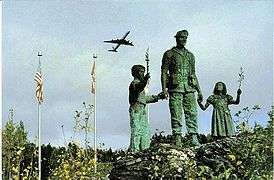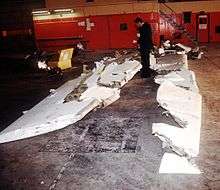Arrow Air Flight 1285
|
Wreckage from Arrow Air Flight 1285 in storage at a Gander Airport hangar on December 16, 1985 | |
| Accident summary | |
|---|---|
| Date | 12 December 1985 |
| Summary | Icing conditions, weight and reference speeds miscalculation (on board fire and possible internal explosion per minority report) |
| Site |
Gander, Newfoundland, Canada 48°54′43″N 54°34′27″W / 48.91194°N 54.57417°WCoordinates: 48°54′43″N 54°34′27″W / 48.91194°N 54.57417°W |
| Passengers | 248 |
| Crew | 8 |
| Fatalities | 256 (all) |
| Survivors | 0 |
| Aircraft type | McDonnell Douglas DC-8-63CF |
| Operator | Arrow Air |
| Registration | N950JW |
| Flight origin | Cairo International Airport, Egypt |
| Stopover |
Cologne Bonn Airport, West Germany |
| Last stopover | Gander International Airport, Newfoundland, Canada |
| Destination | Fort Campbell, Kentucky, United States |


Arrow Air Flight 1285 was a McDonnell Douglas DC-8 jetliner that operated as an international charter flight carrying U.S. troops from Cairo, Egypt, to their home base in Fort Campbell, Kentucky, via Cologne, West Germany and Gander, Canada.[1]
On the morning of Thursday, 12 December 1985, shortly after takeoff from Gander en route to Fort Campbell, the aircraft stalled, crashed, and burned about half a mile from the runway, killing all 248 passengers and 8 crew members on board.[2] As of December 2015, it has the highest death toll of any aviation accident on Canadian soil and the second-highest of any accident involving a DC-8,[3] behind the crash of Nigeria Airways Flight 2120 six years later.
The accident was investigated by the Canadian Aviation Safety Board (CASB), which determined the probable cause of the crash was the aircraft's unexpectedly high drag and reduced lift condition, most likely due to ice contamination on the wings' leading edges and upper surfaces, as well as underestimated onboard weight.[4] A minority report stated that the accident could have been caused by an onboard explosion of unknown origin prior to impact.[5]
Flight history
%2C_Arrow_Air_JP5941304.jpg)
The aircraft, a McDonnell Douglas DC-8-63CF, was chartered to carry U.S. Army personnel, all members of the 101st Airborne Division, back to their base in Fort Campbell, Kentucky. They had completed a six-month deployment in the Sinai, in the Multinational Force and Observers peacekeeping mission.[3] The DC-8 involved in the accident (registration N950JW)[6] had been constructed in 1969, and had been leased to Arrow Air by its owner/parent company, International Air Leases.[7]
The flight was made up of three legs, with refueling stops in Cologne and Gander.[8] The aircraft departed Cairo at 20:35 Greenwich Mean Time (GMT), and arrived at Cologne on 12 December 1985, at 01:21 GMT.
A new flight crew (consisting of Captain John Griffin and First Officer Joseph Robert "Bob" Connelly, both 45, and Flight Engineer Michael "Mike" Fowler, 48) boarded the aircraft before it departed for Gander at 02:50 GMT.[8] The aircraft arrived at Gander International Airport at 09:04, where passengers departed the aircraft while the aircraft was refueled. Witnesses reported the flight engineer conducted an external inspection of the aircraft, after which the passengers re-boarded the aircraft.[8]
The DC-8 began its take-off roll on runway 22 from the intersection of runway 13 at 10:15 UTC (06:45 NST). It rotated near taxiway A, 51 seconds after brake release, at an airspeed of about 167 KIAS.[8] Witnesses reported the aircraft showed difficulty gaining altitude after rotation. Airborne, the airspeed reached 172 KIAS and began to decrease again, causing the DC-8 to descend. After crossing the Trans-Canada Highway, located about 900 feet (270 m) from the departure end of runway 22, at a very low altitude, the aircraft's pitch increased and it continued to descend.[8]
Witnesses driving on the highway stated that they saw a bright glow emanating from the aircraft before it struck terrain just short of Gander Lake and crashed approximately 900 feet (270 m) feet beyond the departure end of the runway.[8] Flight 1285 broke up, struck an unoccupied building[9] and exploded; this started a fire which increased in severity due to the large amount of fuel on board for the final leg of the flight. All 248 passengers and eight crew aboard the aircraft perished.[3][8]
Investigation
The Canadian Aviation Safety Board (CASB) investigated the crash, and, under the signature of five of nine board members, found that during its approach toward Gander, precipitation conditions were favorable for the formation of ice on the aircraft's wings. After landing, it continued to be exposed to "freezing and frozen precipitation capable of producing roughening on the wing upper surface" in addition to the freezing temperature. They also found that prior to takeoff the aircraft had not been de-iced.[10] The Board issued the following Probable Cause statement in its final report:[3][4]
The Canadian Aviation Safety Board was unable to determine the exact sequence of events which led to this accident. The Board believes, however, that the weight of evidence supports the conclusion that, shortly after lift-off, the aircraft experienced an increase in drag and reduction in lift which resulted in a stall at low altitude from which recovery was not possible. The most probable cause of the stall was determined to be ice contamination on the leading edge and upper surface of the wing. Other possible factors such as a loss of thrust from the number four engine and inappropriate take-off reference speeds may have compounded the effects of the contamination.
Four (of nine) members of the CASB dissented, issuing a minority opinion asserting that there was no evidence presented proving that ice had been present on leading edges such as the wings, and the minority report speculated that "An in-flight fire that may have resulted from detonations of undetermined origin brought about catastrophic system failures."[5]
The one piece of evidence that could have shown which one is correct was the Cockpit Voice Recorder (CVR). However, this device was defective and failed to record anything. Also, the Flight Data Recorder (FDR) was an older model that only recorded 4 parameters. It was scheduled to be replaced a few weeks later.
Willard Estey, a former Supreme Court of Canada judge, submitted a review of the CASB report in 1989, ruling that the available evidence did not support either conclusion.[11] As a result, the Canadian public's confidence in the CASB was undermined. The federal government responded by creating the Transportation Safety Board of Canada.[12]
Aftermath
On the day of the crash, responsibility was claimed by Islamic Jihad, a wing of Hezbollah. The claim was dismissed by the Canadian and U.S. governments soon afterward.[2][13] According to United Press International "Hours after the crash the Islamic Jihad – a Shiite Muslim extremist group – claimed it destroyed the plane to prove [its] ability to strike at the Americans anywhere." Pentagon and Canadian government officials rejected the claim, made by an anonymous caller to a French news agency in Beirut.[14]
Two hundred fifty-six people died – 248 U.S. servicemen and eight crew members. As of 2009, that death toll constituted the deadliest plane crash in Canada,[15] and the United States Army's single deadliest air crash in peacetime.[16]
Of the 248 servicemen, all but twelve were members of 101st Airborne Division (Air Assault), most of whom were from the 3d Battalion, 502nd Infantry; eleven were from other Forces Command units; and one was an agent from the Criminal Investigations Command (CID).[17]
A memorial to the 256 victims at the crash site overlooks Gander Lake, and another memorial was erected at Fort Campbell. There is also a Memorial Park in Hopkinsville, KY, just north of Fort Campbell. The scar from the crash is still very visible, and can be seen on the ground and in satellite pictures.
In 1991, Les Filotas, one of the four CASB board members who dissented in the final report, published an exhaustive argument for the minority opinion that a possible in-flight explosion doomed the aircraft.[18]
Mark Kerrigan, brother of figure skater Nancy Kerrigan, was serving in the 101st Airborne Division at the time, and was originally intended to be on the flight. He did not board the flight, but 248 members of his unit including his two best friends were on the flight and died. The trauma of losing so many people close to him was said to have caused Kerrigan to suffer from post traumatic stress disorder and have been a significant factor in causing him later legal problems.[19]
Dramatization
The story of the crash was featured on the eleventh season of the Canadian TV series Mayday. The episode is entitled "Split Decision".
Gallery
-

Caskets being carried in for a memorial service at Dover AFB on 16 December 1985
-

The "Silent Witness" Arrow Air Flight 1285 memorial at Gander Lake, with a DC-8 taking off in the background
-

Arrow Air Flight 1285 memorial at Ft. Campbell
See also
- Air Ontario Flight 1363, a similar crash due to icing conditions
- List of accidents and incidents involving commercial aircraft
References
- ↑ "258 killed in Gander plane crash". The Citizen. Ottawa, Canada. Canadian Press. December 12, 1985. p. 1.
- 1 2 "Terror bomb ruled out in Canada's worst crash". Montreal Gazette. news services. December 13, 1985. p. A1.
- 1 2 3 4 Accident description at the Aviation Safety Network
- 1 2 "CASB Majority Report".
- 1 2 "CASB Minority Report".
- ↑ "FAA Registry". Federal Aviation Administration.
- ↑ Sandford.org
- 1 2 3 4 5 6 7 Sandford.org
- ↑ Sandford.org
- ↑ "CASB Majority Report:Findings".
- ↑ "Canada Judge Rejects New Gander Crash Probe". Los Angeles Times. 22 July 1989. Retrieved 27 August 2011.
- ↑ Watson, Blair. "The Transportation Safety Board Taking centre stage to advance aviation safety Archived 25 September 2010 at the Wayback Machine.." Wings at Transportation Safety Board of Canada. July/August 2008. Retrieved on 17 September 2010.
- ↑ "Plane's airworthiness questioned". The Citizen. Ottawa, Canada. staff and wire reports. December 13, 1985. p. 1.
- ↑ Watson, Laurie (6 November 1988). "Errors By Crew Reportedly Cited In Gander Crash". Philadelphia Inquirer, United Press International. p. A33.
- ↑ "Aviation Safety Network". Archived from the original on 28 September 2006. Retrieved 2006-10-22.
- ↑ Wolf, Marion E. (1990). Posttraumatic Stress Disorder: Etiology, Phenomenology, and Treatment. American Psychiatric Pub, p. 127. ISBN 0880482990
- ↑ Gough, Terrence J. (1995). "Tragedy at Gander". Department of the Army Historical Summary Fiscal Year 1986. United States Army Center of Military History.
- ↑ Filotas, Les (1991). Improbable cause: dissent and deceit in the investigation of Canada's worst air disaster. Toronto: Seal Books.
- ↑ Lavoie, Denise (May 26, 2011). "Kerrigan's brother gets 2.5 years for dad assault". Associated Press. Retrieved October 10, 2016.
Further reading
- Final report (Archive) – Canadian Aviation Safety Board
- Dissenting opinion (Archive) – Canadian Aviation Safety Board
External links
| Wikimedia Commons has media related to Arrow Air Flight 1285. |
|
|
- Time Magazine – The Fall of the Screaming Eagles – retrieved 28 Dec 2006
- Time Magazine – Gander: Different Crash, Same Answers – retrieved 28 Dec 2006
- Globalsecurity.org – 1989 Congressional Debates on Gander Crash – retrieved 28 Dec 2006
- Fort Campbell Courier – Gander-related news articles – retrieved 28 Dec 2006
- Gandercanada.com – Photos of the 20th Anniversary Memorial Service in Gander – retrieved 28 Dec 2006
- CBC News – Ceremonies mark anniversary of deadly Newfoundland air crash – retrieved 28 Dec 2006
- CBC News – Broken Arrow: debate continues after 20 years – retrieved 28 Dec 2006
- Rootsweb.com – List of victims – retrieved 28 Dec 2006
- Canadian Air Force – The Silent Witness Memorial in Gander – retrieved 28 Dec 2006
- Fatal Combination for Arrow Air Flight 1285 – Smithsonian Channel
- Rootsweb.com – Photographs of the Gander Memorial in Hopkinsville, Kentucky – retrieved 28 Dec 2006
